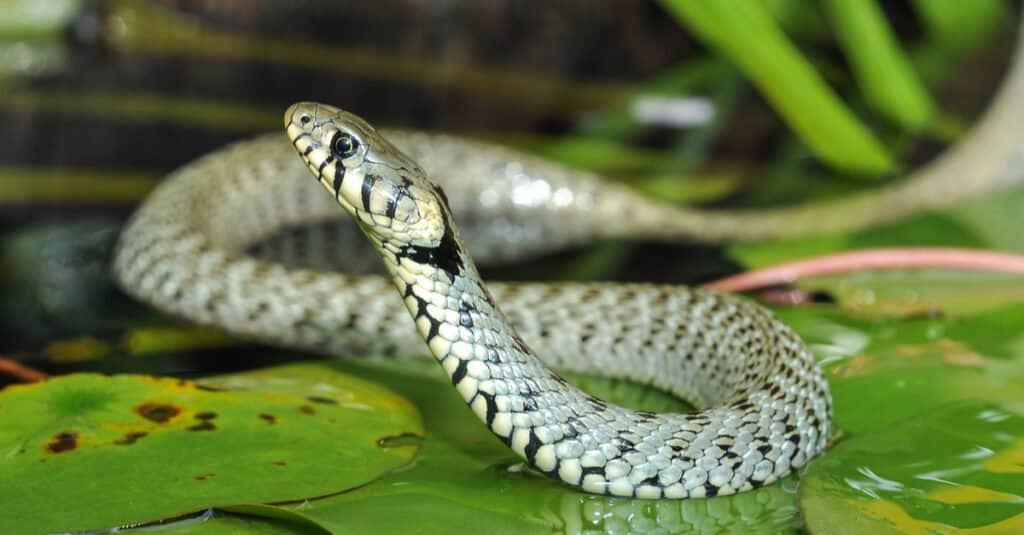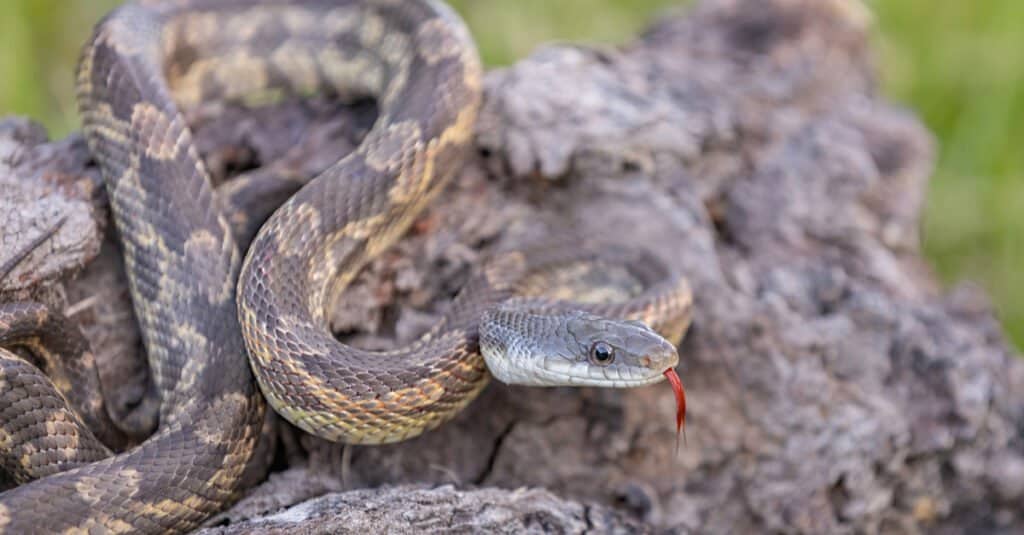It’s easy to imagine a snake slithering under the cover of night, stalking after its prey — but that’s a reductive view that doesn’t account for the fact that there are over 3,000 snake species on every continent apart from Antarctica.
While Ireland and New Zealand have no native snake species, these reptiles have a proven capacity to adapt to practically any ecosystem.
What time of the day they choose to hunt and what seasons they choose to slumber are just two vectors in the natural selection process, but they’re important ones.
Let’s dig deeper into the question of why and when snakes come out.
When Snakes Venture Out to Hunt

©Dr.Pixel/Shutterstock.com
Snakes can be nocturnal, diurnal, or crepuscular, many are flexible. Plus, the sheer scale of both their population distribution and the diversity of overall snake species makes it difficult for researchers to make holistic conclusions about daily snake activity cycles.
Our biggest body of research comes from the Austrian Herpetological Society — which provided an analysis of the hunting habits of snakes in Europe. 68% were purely diurnal, while 15% and 17% of species were crepuscular and nocturnal respectively. These are statistics influenced by one thing more than any other: the cold-blooded nature of snakes.
Many snakes are active at night and some during the day. Snakes are predators and eat a huge variety of animals, including rodents, insects, eggs, and even sometimes young birds. Additionally, scientists discovered some snake species can hunt in packs similar to wolves.
Like all reptiles, snakes are ectotherms. That means that they require an external heat source like the sun or the reflected heat from rocks to power their metabolism. Understandably, that can make them less effective hunters during the night.
Yet the fact that a third of snakes still hunt at least some of the time at night is a testament to the countless other factors that define a snake’s evolution. Let’s look at three species to evaluate why different snakes come out at specific times of the day.
Rattlesnake: Diurnal by Preference
Rattlesnakes can be found throughout the southwest American states, and it’s a combination of that harsh desert climate and the deadly neighbors that these snake species need to contend with that determines their hunting habits.
Studies dating back to 1986 indicate that some rattlesnake species adapted to daytime hunting to avoid predators. Hawks and eagles have keen eyesight to spot prey like rattlesnakes even in dusk and dark, while both the roadrunner and coyote hunt for rattlesnakes on the ground.
But, the rattlesnake’s most prolific predator may be the king snake. This species is almost entirely nocturnal and is resistant to rattlesnake venom. As constrictors, they squeeze their prey to death and are known for their incredible capacity to devour much larger prey.
Unfortunately, the vicious heat of the desert sun means that being active during the day sometimes isn’t feasible. During the hottest months of summer, rattlesnakes in the Sonoran Desert shift their hunting habits out of necessity. While a snake’s metabolism is powered by heat, they still need to remain in a range of around 70 to 90 degrees Fahrenheit to feel comfortable.
At roughly 95 degrees, they can begin to overheat and eventually die. Depending on weather, they’ll either find shade for the hottest points of the day or burrow underground, waiting for cooler night temperatures.
The king snake’s preference for nocturnal hunting was likely influenced similarly, as they’ve been seen exhibiting more crepuscular and diurnal behavior in more temperate ecosystems. Snakes are more sensitive to strong heat than mammals and birds, and that puts species around the world directly in the line of fire for climate change.
Corn Snake: Crepuscular
The vibrant corn snake is also known as the red rat snake thanks to its coloration and its preferred choice of prey. As a crepuscular snake, it’s often active at night but does most of its hunting during the twilight hours of dusk and dawn.
These selective windows of hunting time make the promise of a meal less uncertain, but they also help them catch a meal before natural predators like foxes are out in full force. Their methods are specialized as well.
At dusk, these snakes will hunt through burrows in search of sleeping rodents. Corn snakes are constrictors that will smother their prey to death, and they supplement their diet of mice and other rodents with lizards and especially bird eggs.
But rats are the main prey here, and the corn snake seems to be driven more by the habits of that prey than by the temperature. Rats themselves are crepuscular, and the corn snake will hunker down while they’re inactive.
Roosting underbrush, rocks, leaves, or debris allows them to hide from diurnal predators while waiting for their prey to return in the evening to forage.
Corn snakes have expanded prodigiously throughout much of North America, a feat that they likely wouldn’t have achieved if they weren’t highly adaptable. During lean or opportune times, corn snakes will venture out into the day to poach bird eggs safe in the knowledge that the parents are aware of foraging.
Changes in predator and prey availability could similarly lead to corn snakes being more active later into the night, but they generally sleep through the darkest hours by nature.
Desert Nightsnake: Nocturnal
There’s some symmetry in the fact that desert night snakes and rattlesnakes are often mistaken for one another despite having opposing sleeping and hunting habits. And while it’s true that being in the cold isn’t ideal for snakes, the desert night snake has adapted to maximize its efficiency at hunting. As ambush predators, they don’t have to expend a great deal of energy chasing prey.
And as a venomous species, all they need to do is get a single strike in and then swallow their prey whole once the neurotoxins have done their work. Populations of venomous snakes like vipers tend to be concentrated in humid areas of Africa, Central America, and South America.
They also tend to be nocturnal. Less fortunate is the fact that their elusive and nocturnal natures also make it harder to track them. Daylight is of little concern for these snakes since they detect prey by sensing the air for chemicals — and most snakes will actively avoid humans whenever possible.
While their habitats often overlap, it’s unlikely that rattlesnakes and night snakes encounter one another very often thanks to their opposing times of activity and their differing diets. Night snakes aren’t above eating the occasional mouse or other rodents, a majority of their diet consists of salamanders, frogs, and smaller snakes.
While the rattlesnake is sleeping in preparation for a morning hunt, the night snake is out hunting prey that similarly thrives in the cold of night.
The Cycles of Snake Season

©Silent Shoot/Shutterstock.com
What temperature it is can dramatically affect the habits — or even the capacity for survival — of snake species, but they’ve managed to survive even in seemingly hostile environmental conditions thanks to a form of hibernation known as brumation.
In areas with more variable temperatures, the rise and fall of snake season can be a regular occurrence — albeit one that is sometimes thrown in disarray by what temperature and weather patterns are like in a given area.
In the United States, snake season extends through most of the spring. March or April often constitutes the beginning, but snakes will often continue to be active well into the fall or even winter if conditions are right for hunting. In the American southeast and Mexico, for instance, snakes come out for far longer periods of the year than they do in the cold of Canada and northern states.
They’ll enter a state of brumation when conditions become too cold to sustain their metabolism and when prey itself begins to enter a state of hibernation. Just because a snake is in a state of brumation doesn’t mean that it can’t wake up when it needs to. Extreme temperature and weather changes can lead to a snake awakening and briefly hunting before conditions become inhospitable again.
What temperature a snake finds itself living in can even lead to them not having to bromate at all. The tropical and subtropical climates in which vipers live tend to have less distinct seasons and more generally hospitable conditions for these venomous snakes.
Without the change of temperature — and without a seasonal scarcity of prey as a result — these snakes don’t enter into a state of hibernation as a rule. That doesn’t mean they’re not capable.
During periods of scarcity or extreme weather conditions, they may enter into brumation as an act of survival.
Next Up…
- How Do Sea Snakes Breathe? – Sea snakes are among the most interesting reptiles in the world! So, how do they breath? Click to find out!
- How Often Do Snakes Shed? – As a snake grows, its skin does not grow along with it so it has to shed the outgrown skin. So, how often does this happen? Keep reading to learn more!
- How to Tell if a Snake is Poisonous (By Color and More) – Poisonous snakes are often colorful, click here to learn how to tell if a snake is poisonous!
The photo featured at the top of this post is © DedeDian/Shutterstock.com
Discover the "Monster" Snake 5X Bigger than an Anaconda
Every day A-Z Animals sends out some of the most incredible facts in the world from our free newsletter. Want to discover the 10 most beautiful snakes in the world, a "snake island" where you're never more than 3 feet from danger, or a "monster" snake 5X larger than an anaconda? Then sign up right now and you'll start receiving our daily newsletter absolutely free.
Thank you for reading! Have some feedback for us? Contact the AZ Animals editorial team.






